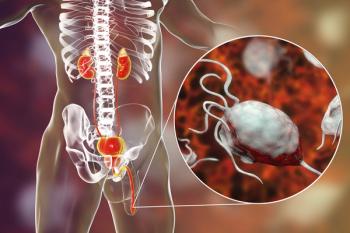
Study Points to Benefit of Radiation Plus Androgen-Deprivation Therapy for Men with Prostate Cancer
Researchers have found that patients with early, localized prostate cancer benefit from short-term androgen-deprivation therapy (ADT) for 4 months prior to and during radiotherapy, and that the addition of ADT increases overall survival and decreases mortality.
Researchers have found that patients with early, localized prostate cancer benefit from short-term androgen-deprivation therapy (ADT) for 4 months prior to and during radiotherapy, and that the addition of ADT increases overall survival and decreases mortality. The benefit was seen mainly in intermediate rather than low-risk men. For high-risk patients, 4 month ADT treatment showed a benefit but the results support previous observations that more than 4 months of treatment are likely necessary for a maximum benefit in this subgroup. The authors say that the results suggest a biological interaction between the combination of short-term ADT and radiotherapy.
Intermediate magnification micrograph of prostate adenocarcinoma; needle core biopsy; HPS stain; source: Wikimedia Commons user Nephron
The trial was a collaboration among the Radiological Associates of Sacramento, the Radiation Therapy Oncology Group Statistical Center at UPenn and radiology departments in Los Angeles, New York, Alberta, Canada, and Montreal, Canada. The results of the study are published in N Engl J Med (N Engl J Med 2011;365:107-18).
The study aimed to address whether short-term ADT both before and during radiotherapy helps control the cancer and improves overall survival for early, localized prostate adenocarcinoma in a randomized, long-term trial. 1979 patients with stage T1b-T2b prostate cancer and PSA levels of 20 ng/ml or less were randomized to radiotherapy alone or radiotherapy with 4 months of total androgen suppression starting 2 months before the radiotherapy treatment.
With a median follow-up of 9.1 years, the 10 year overall survival rate was 62% for patients receiving the combination treatment compared with 57% for patients on radiotherapy alone (P=0.03), a modest but significant improvement. Adding short-term ADT reduced the risk of dying from prostate cancer from 8% to 4% (P=0.001).
The addition of ADT significantly improved biochemical failure, distant metastases, and the rate of positive findings in a 2 year follow-up biopsy. Toxic side effects were comparable in both groups, with a less than 5% incidence of hormone-related toxic effects.
Long-term treatment with oral anti-androgen agents has been shown to improve overall survival, but at the cost of increased toxic effects including erectile dysfunction and myocardial infarctions. The current study bolsters the evidence-base that using short-term ADT provides a clinical benefit while minimizing side effects.
The current study, which enrolled men in the U.S. and Canada from 1994 until 2001 demonstrated that there were slight differences in erectile dysfunction rates between the 2 study groups (21% and 31% of men in the combination versus radiotherapy-alone group were always or almost always able to have an erection at 1 year) and incidences of high grade toxic effects were minimal.
A follow-up study which addresses the benefit of intensity-guided radiation therapy compared with combination radiotherapy and ADT in intermediate-risk prostate cancer is currently ongoing, conducted by the Radiation Therapy Oncology Group and the NCI. The study is enrolling 1500 patients and is scheduled to complete by 2015; it aims to address whether newer radiology techniques provide a benefit on their own without ADT in intermediate-risk men with localized prostate cancer.
Newsletter
Stay up to date on recent advances in the multidisciplinary approach to cancer.


















































































